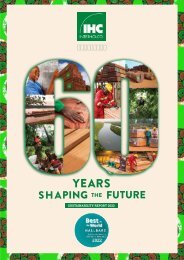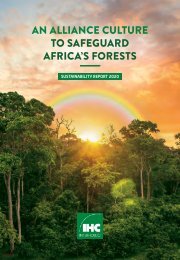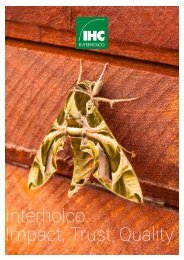Nomenclature Générale des Bois Tropicaux - 7ème édition
(english description below) Cette nomenclature est utilisée pour la mise à jour du 'Harmonized Code System' de l’Organisation Mondiale des Douanes. Dans la circulaire du 5 avril 2005, le Ministère de l’Economie, des Finances et de l’Industrie (France) reconnaît l’ATIBT comme « gardien du temple » de la nomenclature des bois tropicaux. La Commission Européenne mentionne la nomenclature de l’ATIBT comme document de référence pour la mise en œuvre du RBUE. Depuis 1954, l’ATIBT a établi et mis à jour une nomenclature des bois tropicaux faisant correspondre chaque espèce botanique avec un nom pilote reconnu internationalement. La détermination du nom pilote d’une essence est cruciale, car sa commercialisation dépend très largement de l’adoption de ce nom par le public. Le nom pilote assure la protection de l’appellation commerciale de l’essence et l’intégrité des propriétés qui lui sont attribuées, sans risque de confusion. The 1982 version of the general timber nomenclature has finally been updated as some of the 1,750 identified species, are no longer traded, while others, which were not previously included, are now on the market. The present revision has also integrated changes related to new taxonomy, in order to reflect the latest scientific developments. This Nomenclature has been used for the Harmonized Code System, updated by the World Customs Organization. The French Ministry of economy, finance and industry has given official recognition to ATIBT as the reference for the tropical timber nomenclature (NOR: PRMX0508285C of April 5th 2005). The European Commission refers to ATIBT nomenclature as a reference document for the implementation of the EUTR regulation. Since 1954, ATIBT has established and updated a nomenclature of tropical wood, linking each botanical species with an internationally recognized pilot name. A sigle wood species may have many common names; when trading across different countries, this may lead to confusion. Fixing the pilot name of a timber species is crucial, to protect the commercial denomination of the species and guarantee the veracity of the properties linked to that species, without confusion.
(english description below)
Cette nomenclature est utilisée pour la mise à jour du 'Harmonized Code System' de l’Organisation Mondiale des Douanes. Dans la circulaire du 5 avril 2005, le Ministère de l’Economie, des Finances et de l’Industrie (France) reconnaît l’ATIBT comme « gardien du temple » de la nomenclature des bois tropicaux. La Commission Européenne mentionne la nomenclature de l’ATIBT comme document de référence pour la mise en œuvre du RBUE.
Depuis 1954, l’ATIBT a établi et mis à jour une nomenclature des bois tropicaux faisant correspondre chaque espèce botanique avec un nom pilote reconnu internationalement. La détermination du nom pilote d’une essence est cruciale, car sa commercialisation dépend très largement de l’adoption de ce nom par le public. Le nom pilote assure la protection de l’appellation commerciale de l’essence et l’intégrité des propriétés qui lui sont attribuées, sans risque de confusion.
The 1982 version of the general timber nomenclature has finally been updated as some of the 1,750 identified species, are no longer traded, while others, which were not previously included, are now on the market. The present revision has also integrated changes related to new taxonomy, in order to reflect the latest scientific developments.
This Nomenclature has been used for the Harmonized Code System, updated by the World Customs Organization. The French Ministry of economy, finance and industry has given official recognition to ATIBT as the reference for the tropical timber nomenclature (NOR: PRMX0508285C of April 5th 2005). The European Commission refers to ATIBT nomenclature as a reference document for the implementation of the EUTR regulation.
Since 1954, ATIBT has established and updated a nomenclature of tropical wood, linking each botanical species with an internationally recognized pilot name. A sigle wood species may have many common names; when trading across different countries, this may lead to confusion. Fixing the pilot name of a timber species is crucial, to protect the commercial denomination of the species and guarantee the veracity of the properties linked to that species, without confusion.
You also want an ePaper? Increase the reach of your titles
YUMPU automatically turns print PDFs into web optimized ePapers that Google loves.
60 ///
Nomenclature générale des bois tropicaux 2016
PILOT NAME BOTANICAL NAMES COMMON NAMES
Dibétou
Difou
Divida
Djohar
Lovoa swynnertonii Harms
Lovoa trichilioides Harms
(Syn. Lovoa klaineana)
Morus mesozygia Stapf
(Syn. Morus lactea)
Scorodophloeus zenkeri Harms
Senna siamea H.S. Irwin & Barneby
(Syn. Cassia siamea)
African Walnut (GH) ; Anamenila (NG) ; Apopo
(NG) ; Bibolo (CM) ; Bombulu (CD) ; Bosso (CG) ;
Boyo Kondi (CF) ; Dibétou (CI) ; Dubini-Biri (GH) ;
Embero (GQ) ; Eyan (GA) ; Lifaki Muindu (CD) ;
Mpengwa (GH) ; Mukongoro (KE) ; Mukusu (UG) ;
Nkoba (UG) ; Nvero (GQ) ; Sida (NG) ; Wnaimei
(SL)
Aye (NG) ; Bonde (CF) ; Difou (CI) ; Kankate (CD) ;
Kesse (CG) ; Mecodze (MZ) ; Ossel (CM) ; Wonton
(GH)
Divida (CD) ; Esungang (GA) ; Nsigna (GA) ; Olom
(CM) ; Ufili (CG)
Bujuk (ID) ; Djohar (ID) ; Humbo (VN) ; Johor
(MY) ; Khilek (TH) ; Manje-Konna (IN) ; Minjri
(IN) ; Muong Ten (VN) ; Robles (PH) ; Sebusok
(MY)
Douka Tieghemella africana Pierre Douka (CM, GA) ; N’Duka (CG) ; Okola (GQ)
Doussié
Drago
Duabanga
Dukali
Dungun
Durian
Dysox
Ebano
Ebène d’Afrique
Afzelia africana Sm.
Afzelia bella Harms
Afzelia bipindensis Harms
Afzelia pachyloba Harms
Afzelia quanzensis Welw.
(Syn. Afzelia cuanzensis)
(Syn. Intsia cuanzensis)
Pterocarpus officinalis Jacq.
Duabanga grandiflora Walp.
Duabanga moluccana Blume
Parahancornia fasciculata Benoist
Heritiera fomes Buch.
Heritiera littoralis Aiton
Heritiera sylvatica S. Vidal
Heritiera p.p. (AS)
Coelostegia griffithii Benth.
Coelostegia spp.
Durio zibethinus L.
Durio spp.
Neesia spp.
Dysoxylum arborescens Miq.
Dysoxylum densiflorum Miq.
Dysoxylum mollissimum Blume
Dysoxylum spp.
Caesalpinia sclerocarpa Standl.
(Syn. Libidibia sclerocarpa)
Diospyros crassiflora Hiern
Diospyros mespiliformis Hochst.
Diospyros viridicans Hiern
Diospyros p.p.
Aligna (NG) ; Apa (NG) ; Azodau (CI) ; Bolengu
(CD) ; Chanfuta (MZ) ; Doussié (CM) ; Edoumeuleu
(GA) ; Kpakpatin (BJ) ; Kpendei (SL) ; Lingué (CI,
SN) ; M’Banga (CM) ; Mbembakofi (TZ) ; Mkora
(TZ) ; Mussacossa (MZ) ; N’Kokongo (AO, CG) ;
Pakpajide (BJ) ; Papao (GH) ; Pau Conta (GW) ; Uvala
(AO)
Bébé (SR) ; Drago (BR) ; Drago (DO, VE) ; Lagunero
(VE) ; Montouchi de savane (GF) ; Palo de Pollo
(PR) ; Sangre (GT, HN) ; Sangre de Drago (CR, GT,
HN, NC, PA) ; Sangrillo (CR, PA)
Duabanga (PG) ; Kalam (ID) ; Lampati Ramdala
(IN) ; Linkwai (TH) ; Loktob (PH) ; Magas (MY) ;
Magasawith (MY) ; Myaukngo (MM) ; Phay (TH,
VN) ; Phay-Sung (MY) ; Tagahas (MY)
Amapa amargoso (BR) ; Amapazinho (BR) ; Dukali
(GY) ; Mapa (GF, SR) ; Naranja podrida (PE)
Dungun (ID, MY) ; Heritiera (PG) ; Kanazo, Pink
(MM) ; Sundri (IN)
Apa apa (MY) ; Bengang (MY) ; Du yin (MM) ; Durian
(ID, MY) ; Durian Isa (MY) ; Punggai (MY)
Dysox (PG) ; Dysox, Red (PG) ; Membalun (MY) ;
Stavewood (AU)
Divi-Divi (JM, TT) ; Ebano (MX) ; Guatapaná (VE) ;
Nacascol (CO)
Abokpo (NG) ; Bingo (CF) ; Cubaga (BJ) ; Ebano
(GQ) ; Ebene (BJ) ; Epinde-Pinde (CM) ; Evila (GA) ;
Kanran (NG) ; Mavini (CM) ; Mevini (CM) ; Mopini
(CG) ; Ndou (CM) ; Ngoubou (CF) ; Nyareti (NG) ;
Osibin (NG)














